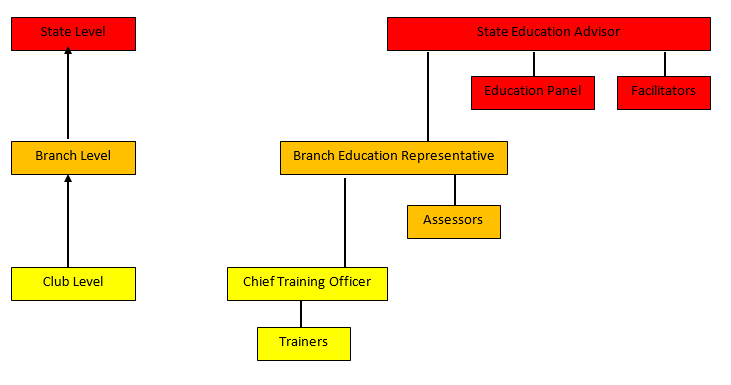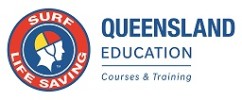
COMMON ACRONYMS
| AM | Age Manager |
| ART | Advanced Resuscitation Techniques |
| ASQA | Australian Skills Quality Authority |
| AQF | Australian Qualifications Framework |
| BM | Bronze Medallion |
| C | Competent |
| CBA | Competency Based Assessment |
| CBT | Competency Based Training |
| CERT II | Certificate II in Public Safety (Aquatic Rescue) |
| CERT III | Certificate III in Public Safety (Aquatic Rescue) |
| CERT IV | Certificate IV in Training and Education |
| CPR | Cardiopulmonary Resuscitation |
| CT | Credit Transfer |
| CTO | Chief Training Officer |
| CYRMS | Child & Youth Risk Management Strategy |
| DAG | Delivery and Assessment Guide |
| DNA | Did Not Attend |
| DNC | Did Not Complete |
| DS | Direct Supervision |
| ECT | Emergency Care Training |
| EDC | Education Development Coordinator |
| FA | First Aid |
| GM | Gold Medallion |
| IRB | Inflatable Rescue Boat |
| IRBC | IRB Crewperson |
| IRBDC | IRB Driver |
| JAAO | Junior Activities Accreditation Officer |
| JAC | Junior Activity Chairperson |
| JDR | Junior Development Resource |
| LUI | Learner Unique Identifier |
| NRT | Nationally Recognised Training |
| NYC | Not Yet Competent |
| POM | Patrol Operations Manual |
| QCE | Queensland Certificate of Education |
| QFES | Queensland Fire and Emergency Services |
| RCC | Recognition Current Competency |
| RNG | Recognition Not Given |
| ROC | Radio Operator Certificate |
| RPL | Recognised Prior Learning |
| RTO | Registered Training Organisation |
| SLSA | Surf Life Saving Australia |
| SLSC | Surf Life Saving Club |
| SLSQ | Surf Life Saving Queensland |
| SM | Silver Medallion |
| SMBM | Silver Medallion Beach Management |
| SME | Subject Matter Expert |
| SMIRB | Silver Medallion IRB Drivers |
| SRC | Surf Rescue Certificate |
| SSV | Side by Side Vehicle |
| TACO | Training and Assessment Coordinator (IRBs) |
| TAF | Trainer, Assessor and Facilitators |
| UOC | Unit of Competency |
| USI | Unique Student Identifier |
| VET | Vocational Education and Training |
DEFINITIONS/REFERENCES
Clarification between “Training” and “Education & Training” within Constitutions, Bylaws, Policies, Procedures etc:
Any references to the term “Training” and “Education and Training” within this Manual or other SLSQ documentation should be referred to as one in the same and relates to any instruction given to a club member enrolled in any formal education course training whether that be at a club, branch or state level.
Course Enrolment – means any financial member participating in an education course who is currently registered/enrolled in an Assessment Request on Surfguard.
POSITION DESCRIPTIONS
CLUB CHIEF TRAINING OFFICER – POSITION DESCRIPTION (SAMPLE ONLY):
The CHIEF TRAINING OFFICER shall:
a) be a qualified TAE Cert IV in Training and Assessing or be actively working towards the qualification with a defined agreement with a Certificate IV TAE holder to act as Course Supervisor for the season;
b) conduct, oversee, or assist in the instruction and preparation of all members awards training and probationary members for Award examinations;
c) maintain an up-to-date knowledge of the latest methods of Surf Life Saving and the Training Manuals and impart such knowledge to all Club, Trainers, Assessors and Facilitators;
d) coordinate club run proficiency days;
e) attend all SLSQ and Branch CTO Meetings and training days;
f) be the Club’s representative on the Branch CTO Committee;
g) liaise and coordinate with the Captain the requirement to have additional award holders trained for any short fall in patrol teams to meet the required Club’s Patrol Agreement to SLSQ;
h) be responsible for the care, maintenance and housing of Club lifesaving training equipment;
i) maintain adequate stocks of approved training consumables, material and equipment provided that he must first obtain the approval of the Club Board of Management for the purchase of materials or equipment;
j) maintain the training room and equipment in a clean and orderly condition and for that purpose, may call on the services of any member; and
k) present a yearly budget covering all financial matters associated with facilitating and conducting club training activities.
BRANCH EDUCATION OFFICER/DIRECTOR OF EDUCATION – POSITION DESCRIPTION (SAMPLE ONLY):
The Education Officer shall –
(i) be the holder of a current SLSA Assessor’s Certificate, and be a current proficient member of the Branch Board of Life Saving;
(ii) have the necessary skills and experience in teaching activities, and be responsible for a program of activity concerned with educating the members and the community at large on all matters of practical life saving and surf safety.
(iii) recommend action in specific areas of concern that require the preparation and promulgation of material, and shall attend the Board of Life Saving meetings applicable thereto;
(iv) initiate the conducting of conferences and assist with the preparation of agendas, supply of lecturers and set formats for other meetings where education forms a major portion of the objective;
(v) liaise with Officers holding similar positions at National, State or Branch levels;
(vi) supervise through a small committee representative of the Clubs, and other education experts the establishment and operation of the Branch and each Club’s educational operations; and
(vii) be responsible to the Director of Life Saving provided that reporting shall be through the Branch and redirected to the Executive Officer concerned.
SURF LIFE SAVING QUEENSLAND EDUCATION ADVISOR – POSITION DESCRIPTION:
Education Advisor must –
i) be appointed by the Board on a recommendation of the State Lifesaving Committee;
ii) be the holder of a current SLSA Assessor Certificate;
iii) hold a current Blue Card or Exemption Notice issued by the Blue Card Services;
iv) have the necessary skills and experience in teaching activities, and be responsible for a program of activity concerned with education, of the members and the community at large on all matters of practical life saving and surf safety;
v) attend meetings of the State Lifesaving Committee when requested; recommend action in specific areas of concern that require the preparation and promulgation of material;
vi) initiate the conduct of conferences and assist with the preparation of agendas, supply of lecturers and set formats for other meetings where education forms a major portion of the objective;
vii) liaise with Officers holding similar positions at National, State and Branch levels;
viii) supervise through a small committee representative of the Branches and other education experts, the establishment and operation of Branch and Club educational programs; and
ix) attend to all matters referred by the State Lifesaving Officer.
SURF LIFE SAVING QUEENSLAND EDUCATION PANEL:
Lifesaving Education Panel –
i) The State Lifesaving Committee must appoint a State Lifesaving Education Panel, from a
recommendation of the State Lifesaving Education Advisor.
ii) The Panel must comprise of:
a. the State Lifesaving Education Advisor who is the Chairperson;
b. six (6) Branch Representatives with current training and assessing qualifications and experience;
c. 2 x Industry Experts;
d. the Chief Lifeguard or their nominee;
e. other Advisors or specialist officers (as required);
f. the State Lifesaving Officer or nominee (ex-officio);
g. Education Development Officers (non-voting);
h. the CEO or nominee (non-voting) who is the Secretary.
iii) Continued membership of the Panel depends on the following points, and is subject to the Panel’s or the State Education Advisor’s recommendations:
a. satisfactory attendance at meetings and functions arranged by the Panel;
b. performance of the duties required by the Panel or the Education Advisor;
c. acceptance of appointment to sub-committees or groups detailed for specific tasks on behalf of the Panel or State Lifesaving Committee.
iv) Meetings of the Panel must be held on a regular basis, on dates as determined by the Panel or the
Chairperson, at least three times per year;
v) Powers and duties of the Panel are:
a. to develop, coordinate and implement activities and programs related to lifesaving, education and training and specifically relevant priorities as determined by the State Lifesaving Committee;
b. to develop and monitor the Lifesaving Education & Training plan;
c. to ensure the adequacy of SLSQ member education and training resources and programs;
d. to provide advice and recommendations on matters of policy to the State Lifesaving Committee;
e. to ensure the activities and standards of all SLSQ Trainers and Assessors meet SLSA and industry (e.g. standards for RTO’s);
f. to liaise closely with the State Lifesaving Committee on matters relating to lifesaver and lifeguard qualifications, training and education systems, standards for RTO’s and services;
g. to provide minutes, reports and recommendations to the State Lifesaving Committee on all
meetings, investigations and projects;
h. to facilitate schools of training, conferences and seminars; and
i. to deal with matters referred to it from time to time by the State Lifesaving Committee.
HOW THE POSITIONS FIT TOGETHER





Post your comment on this topic.